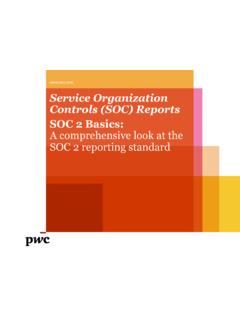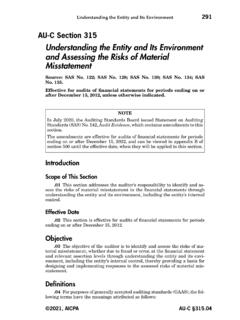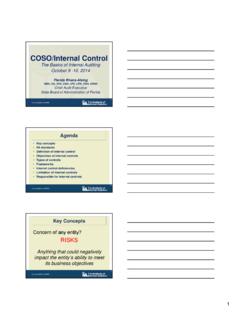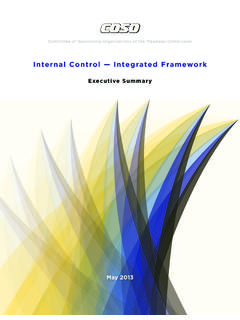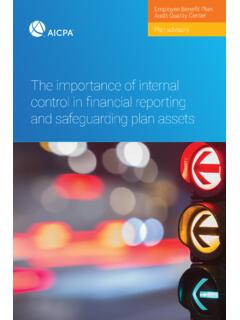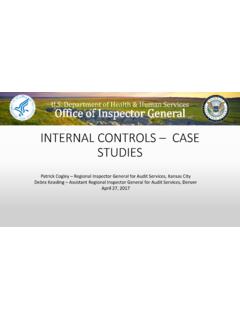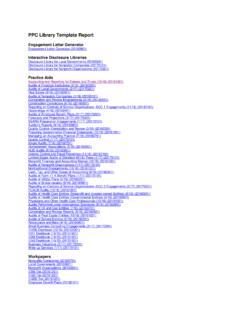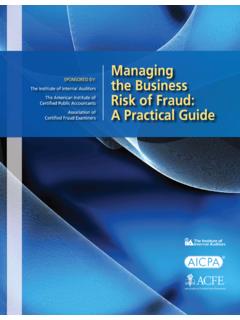Transcription of INTERNAL CONTROLS: AICPA - INTERNAL CONTROL …
1 INTERNAL CONTROLS: AICPA - INTERNAL CONTROL standards : The information that follows is specific guidance from the american institute of certified public accountants Codification on Statements on Auditing standards AU319 INTERNAL CONTROL in a Financial Statement Audit . INTERNAL CONTROL is a process effected by an entity s board of directors, management, and other personnel designed to provide reasonable assurance regarding the achievement of objectives in the following categories: (a) reliability of financial reporting, (b) effectiveness and efficiency of operations, and (c) compliance with applicable laws and regulations.
2 INTERNAL CONTROL consist of five interrelated components, which are: CONTROL environment sets the tone of an organization, influencing the CONTROL consciousness of its people. It is the foundation for all other components of INTERNAL CONTROL , providing discipline and structure. Risk assessment is the entity s identification and analysis of relevant risks to achievement of its objectives, forming a basis for determining how the risks should be managed.
3 CONTROL activities are the policies and procedures that help ensure that management directives are carried out. Information and communication are the identification, capture, and exchange of information in a form and time frame that enable people to carry out their responsibilities. Monitoring is a process that assesses the quality of INTERNAL CONTROL performance over time. CONTROL ENVIRONMENT: Factors effecting the CONTROL environment include: integrity and ethical values, commitment to competence, board of director or audit committee participation, management s philosophy and operating style, organizational structure, assignment of authority and responsibility, and human resource policies and practices.
4 Integrity and Ethical Values: The effectiveness of controls cannot rise above the integrity and ethical values of the people who create, administer, and monitor them. Integrity and ethical values are essential elements of the CONTROL environment, affecting the design, administration, and monitoring of other components. Integrity and ethical behavior are the product of the entity s ethical and behavioral standards , how they are communicated, and how they are reinforced in practice.
5 They include management s actions to remove or reduce incentives and temptations that might prompt personnel to engage in dishonest, illegal, or unethical acts. They also include the communication of entity values Understanding INTERNAL Controls 1/6/2015 and behavioral standards to personnel through policy statements and codes of conduct and by example.
6 Commitment to Competence: Competence is the knowledge and skills necessary to accomplish tasks that define the individual s job. Commitment to competence includes management s consideration of the competence levels for particular jobs and how those levels translate into requisite skills and knowledge. Board of Directors or Audit Committee Participation: An entity s CONTROL consciousness is influenced significantly by the entity s board of directors or audit committee. Attributes include the board or audit committee s independence from management, the experience and stature of its members, the extent of its involvement and scrutiny of activities, the appropriateness of its actions, the degree to which difficult questions are raised and pursued with management, and the interaction with INTERNAL and external auditors.
7 Management s Philosophy and Operating Style: Management s philosophy and operating style encompass a broad range of characteristics. Such characteristics may include the following: management s approach to taking and monitoring business risks, management s attitudes and actions towards financial reporting (conservative or aggressive selection from available alternative accounting principles, and conscientiousness and conservatism with which accounting estimates are developed).
8 And management s attitude toward information processing and accounting functions and personnel. Organizational Structure: An entity s organizational structure provides the framework within which its activities for achieving entity-wide objectives are planned, executed, controlled, and monitored. Establishing a relevant organizational structure includes considering key areas of authority and responsibility and appropriate lines of reporting.
9 An entity develops an organizational structure suited to its needs. The appropriateness of an entity s organizational structure depends, in part, on its size and the nature of its activities. Assignment of Authority and Responsibility: This factor includes how authority and responsibility for operating activities are assigned and how reporting relationships and authorization hierarchies are established. It also includes policies relating to appropriate business practices, knowledge and experience of key personnel, and resources provided for carrying out duties.
10 In addition, it includes policies and communications directed at ensuring that all personnel understand the entity s objectives, know how their individual actions interrelate and contribute to those objectives, and recognize how and for what they will be held accountable. Human Resource Policies and Practices: Human resource policies and practices relate to hiring, orientation, training, evaluating, counseling, promoting, compensating, and remedial plans.
